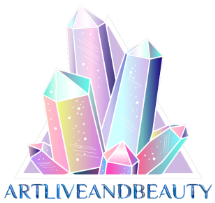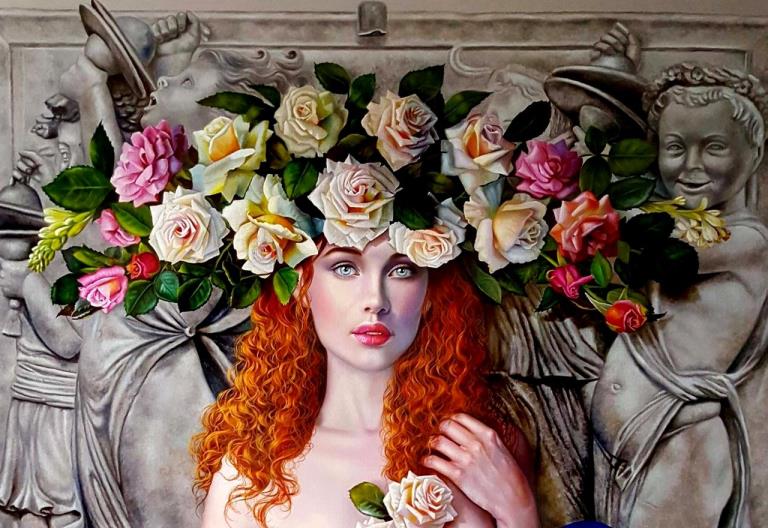Artist-Patrizia-Rizzo's-Paintings
Patrizia Rizzo is a contemporary Venezuelan hyperrealistic Painter , She Was born in 1953, figurative artist, and instructor. Captivated by feminine beauty, she depicts it in her works. Her art is mostly concerned with women. We can observe magnificent hues and a variety of colours in her works. Ladies of various ethnicities and skin tones. Gorgeous and extremely appealing.
I found This Interesting Interview With Artist Patrizia Rizza which made By The Interviewer Cody Weddle.
- Tell me where we are. What am I seeing around me? Telling me about your work? Your Gallery?
- Well, we are in an art Gallery that is the result of many years of work. I've been working here for 30 years as a painting teacher and as a painter. I have developed my career in here. As you can see, I'm a figurative artist, an academic artist. Some people deemed my work to be part of hyperrealism, but I say that I'm not that I am a figurative and realistic artist. These paintings you see here are part of my work. I tend to work the human figure and also something we call still life.
I am passionate about this topic with the figurative art. The viewer understands the figure that is shown in the artwork. It is comprehensible to the viewer. The figure can be a human being can be still life or even flowers, everything that is figurative and that can be easily grasped by the human eye. Whatas realistic art is a technique that is a closed observation of outward appearances. The picture could be seen as if it was real. That is why I'm told to be hyperrealistic artist. However, I tell people that hyperrealism is something else.
In hyperrealism, the figure has a different composition. Hyperrealistic images are typically ten or 20 times the size of the original photographic reference source. For example, hyperrealistic artwork are those one knots you see there. The figure is bigger than the reality.
- And what is it that you love about this?
- I chose to paint some elements precisely because they are beautiful. I believe I'm lucky because the public likes what I paint. It could be because you face different challenges during your life. Therefore, it is necessary that you focus on what is beautiful and you relax and feel like in a different dimension. I've always felt attracted to a lifestyle that allows you to be part of this discipline. Actually, I have a strong character, but I'm always calm and it is because I'm always contemplative. I don't think many people can do it with other disciplines.
That's the way it is. The world is a hurry. You're always trying to achieve your goal. But painting relaxes you.
It's amazing. No matter the issues you have to deal with in daily life, you get involved in this world in a way that you live, not a fictitious life because you're always focused on reality, but in a way that is abstract, you are always contemplative. You're always in abstraction. So you imagine create and recreate. Actually, painting has always been decorative art, even when you have rebellious painting or one that is part of another genera. But I like to embellish everything. And when you do that, you get involved with everything that is beautiful.
- And you said you like finding the beauty and things. Where else do you get your inspiration for your painting?
- Inspiration depends on different factors. For example, when I paint the human body, I only need a person that I consider to be beautiful. He or she could be passing by, and I say think of them as one of my models. But beauty is not always the stereotypical beauty because a painter does not only focus on a beautiful face, a painter goes beyond and tries to explore what is the inside. It could be an expression, a gesture or a move that makes you go back on time or that reminds you of a situation of interest.
And then you try to show that person with a special attitude. I also believe that the environment you are functions as inspiration. It could be some fruits. Sometimes you see them and you just want to eat them. But I could see them and say how beautiful they are. I want to paint them. You could be inspired by any element, and I actually think that you should not see it and wait for inspiration. One of the key issues for artists is to live in a continuous inspiration in a continuous and absolute inspiration.
Anything could be useful. Anything. The important thing is how you use it to come up with something new out of it, that it conveys a message. Filler beauty. For example, you could take a banana that is a common fruit, but you can turn it into something beautiful.
- I'm sure you haven't only shown them here in Venezuela. Tell me where else you have exhibited your your works.
- Yes, I have presented my work in many international exhibitions. I participated in international festivals. I worked for galleries abroad. I participated in festivals held in Tokyo, Berlin, also in Miami, Palm Beach and in Miami. Centre were quite important. Festivals are held annually in January and what I have participated in several times. I have also participated in the international festivals held here in Caracas, such as the FIA. You might have heard of it. I have many international clients as well. I have clients in Amsterdam, in Paris. There are people requesting for my work. They sometimes purchase it online or directly. Buy it in galleries that promote my artworks.
- And you also you are telling me that you teach here, tell me a little bit about that.
- The academy was founded 30 years ago. At the beginning, there were just a few students. But then news about my academy started to spread. A student would bring more students. They got excited about the academy. They really liked the way I taught. Nowadays, I have an academy field with the students. There are more than 200 students. They are very promising. I am very proud of them.
- What do you like more having your academy, teaching, sharing your knowledge or the actual. Artwork that you ?
- That's a difficult question. Both activities have been truly rewarding for me. On one hand, teaching is fulfilling because you feel you're forming the future generation that will live in something to future generations. On the other hand, painting is a unique activity, so eventually I think that I will devote myself exclusively to my painting. Because while teaching can be really fulfilling, it also takes away too much time. Sometimes you might find yourself without time to not only to paint but to create. The creative process requires space and tranquility. Two things you don't have when you teach. However, I would like to continue teaching for a while longer. I actually enjoy teaching just as much as painting. I mean, I've been teaching for 30 years now, so that must mean something.
- And let's talk about art here in Venezuela and how it's seen around the world is is our artist and Venezuelan artist well known around the world? Is there a small niche community here in Venezuela?
- Well, Venezuela has certain prestige abroad regarding arts, but regarding plastic arts specifically, we're not that positioned. I think we should promote plastic arts much more. Some efforts have been made within the arts in Venezuela that present the country internationally, but such efforts have been made for disciplines like music. We now have a national orchestra that is known worldwide and also theater, which is a field that we can tell is having a significant growth in plastic. But plastic arts have not been addressed, and a country can only position itself abroad by addressing the masses. Saenz is there in the masses where you can find the young talent that hasn't been discovered yet. We need to discover that new talent. Believe it or not, the most internationally famous Venezuelan works of art are from another time period that from the beginning of the century, for example, the works of Arturo Mytilene, Cristobal Rojas and Towery Tovar, who are the artistic giants of history and whose works are exhibited in great places such as the legislative palace or the birthplace house of Simon Bolivar. But they are not painters of this age with the same relevance as the previously mentioned ones, and I think it's not because Venezuela lacked the talent or the abilities for plastic artists. On the contrary, there are plenty of talent in Venezuela, but I think it hasn't been properly channeled to achieve just as much as the National Orchestra has achieved or as the theater is starting to achieve. We need to support the youth, the young talent. A lot of young people that are eager to learn come to my academy, but I think the youth is not supported enough. We need to promote plastic arts more.





















































No comments:
Post a Comment